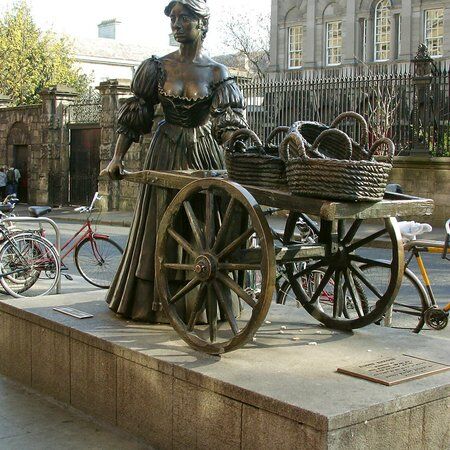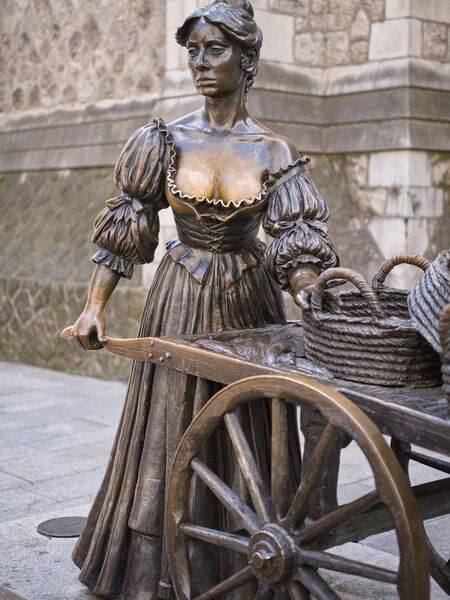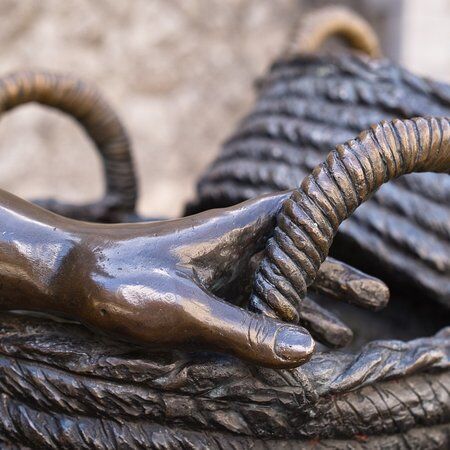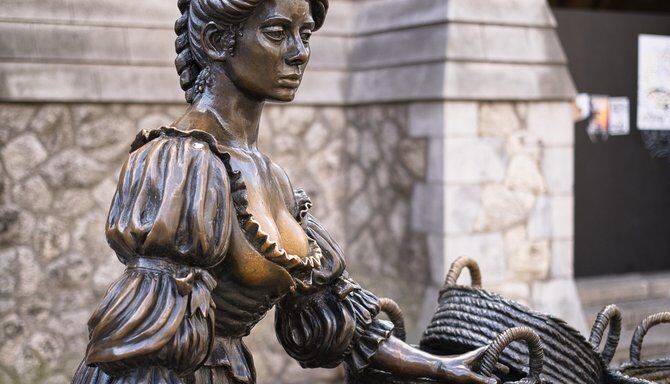
Discover the Molly Malone Statue
Immortalised in bronze, the Molly Malone Statue depicts a character from Dublin's unofficial anthem "Sweet Molly Malone," pushing a cart filled with cockles and mussels through Suffolk Street, in the centre of Dublin. As the heroine in the song, Molly Malone, was a beautiful young fishmonger who sold her wares from the cart by day and, according to some interpretations, engaged in less reputable activities by night.
However, no one really knows how the song came about or whether Molly was a real person but people still visit the statue to pay their respects and reap some luck—look out for areas where the bronze has worn away! In fact, according to Fáilte Ireland, the national tourism development authority, the statue significantly contributes to the city’s economy as one of Dublin’s top tourist attractions. Over 500,000 tourists visit Dublin annually specifically to see the statue and capture photos with it.

The Lyrics of “Sweet Molly Malone”
Over the years, the song "Sweet Molly Malone," also known as "Cockles and Mussels" or "In Dublin’s Fair City," has been recorded by artists such as Sinéad O’Connor, Pete Seeger, and The Dubliners. Despite its deep association with Dublin, the song's origins and history are very complex. The most commonly known version of the song is as follows:
In Dublin’s Fair City
Where the girls are so pretty
I first set my eyes on sweet Molly Malone
As she wheel’d her wheelbarrow
Through streets broad and narrow
Crying cockles and mussels alive, alive o!
Chorus
Alive, alive o! Alive, alive o!
Crying cockles and mussels alive, alive o!
She was a fishmonger
But sure ’twas no wonder
For so were her father and mother before
And they each wheel’d their barrow
Through streets broad and narrow
Crying cockles and mussels alive, alive o!
Chorus
She died of a fever
And no one could save her
And that was the end of sweet Molly Malone
But her ghost wheels her barrow
Through streets broad and narrow
Crying cockles and mussels alive, alive o!
Chorus

Origins of the Molly Malone Legend
The story of Molly Malone, as depicted by the famous song, tells of a young fishmonger who roamed the streets of Dublin, selling her catch and calling out "Cockles and mussels, alive, alive, oh!" According to the lyrics, Molly met an untimely death after catching a fever, from here her ghostly presence haunted the city evermore. The song has since become known as the unofficial anthem of Dublin, but its origins have been highly contested.
The earliest known version of "Sweet Molly Malone'' appeared in Boston in 1876 but suggested Irish origins. A variant of the song was also published under the name "Cockles and Mussels," in London in 1884. This version was published by Francis, Day & Hunter Ltd. and credited to James Yorkston, the Scottish composer, with music arranged by Edmund Forman. However, scholar Siobhán Marie Kilfeather, suggests that while the song does resemble the music-hall style popular in Victorian Britain, it's a far cry from traditional Irish ballads.
The mystery surrounding Molly Malone deepened in 2010 with the discovery of an earlier mention of her in a songbook titled "Apollo’s Medley," printed in England in 1790. This earlier version portrays Molly as a resident of Howth, a fishing village near Dublin, and suggests she might have worked as both a fishmonger and a prostitute. This depiction fuels ongoing speculation about her true identity and the origins of her story.

Was Molly Malone a Real Person?
Despite the uncertainty about her existence, Molly Malone has become an enduring figure in Irish folklore. By the late 20th century, she had fallen into legend, with claims that she was a real person who lived in the 17th century. Supporting this legend, a Mary Malone (with "Molly" being a common diminutive of Mary) was recorded to have died in Dublin on June 13, 1699. This date was later proclaimed Molly Malone Day by the Dublin Millennium Commission in 1988, giving her an official place in Ireland’s cultural heritage. However, despite the song’s popularity, there is no concrete evidence that Molly Malone was a real person.

Honouring 1,000 Years: Creating the Molly Malone Statue
In 1988, as part of Dublin's Millennium celebrations, the city commissioned the Molly Malone Statue to be erected on Grafton Street, at the corner of Suffolk Street. The statue was unveiled on 13th June 1988 by the then Lord Mayor of Dublin, Ben Briscoe.
However, the decision to commission the statue was met with controversy. Many critics felt it was inappropriate to spend public funds on a potentially fictional character, as this would only muffle the voices of real women throughout Dublin’s history. Others suggest that the statue’s popularity reflects a tendency in Irish culture to romanticise the past and ignore darker aspects of the country’s history.

Designing the Molly Malone Statue
Created by Irish sculptor Jeanne Rynhart, the statue depicts Molly in traditional yet revealing 17th century attire, a design choice that fueled speculation about her supposed alternate occupation as a prostitute. This aspect of the Molly Malone Statue drew mixed reactions; while some appreciated the historical nod to the public breastfeeding issues at the time, others felt it was an unnecessary sexualization.
Despite controversy, the Molly Malone Statue quickly earned itself a few affectionate nicknames, such as “The Tart with the Cart” and "The Trollop with the Scallops.” It also became one of the city’s most loved landmarks.

Moving the Molly Malone Statue
Originally situated at the bottom of Grafton Street, near Trinity College, the Molly Malone Statue was moved in April 2014 due to construction work on the Luas Cross City project. During the relocation process, some cracks were discovered, necessitating restoration work by Bushy Park Ironworks.
The restoration included returning the statue to its original dark brown colour while preserving the well-worn areas rubbed by countless hands over the years. By July 2014, the statue found a new home outside the Dublin Tourism Centre (formerly St. Andrew's Church) on Suffolk Street, just a short distance from its initial site.
The relocation has not diminished the statue’s popularity; if anything, its new home offers a more spacious and prominent setting for viewers to gather and take pictures.

Modern-Day Traditions Involving the Statue
Since its creation, Molly Malone’s statue has become a popular starting and ending point for walking tours of Dublin. The statue also plays a central role in Dublin’s public celebrations, especially on June 13th—Molly Malone Day—when the city hosts a festival in her honour.
The event includes live music, street performances, and a parade through the city streets, with participants wearing traditional costumes and pushing wheelbarrows filled with cockles and mussels.
In recent years, a tradition has emerged where visitors rub the statue's bosom for good luck, a practice that has left visible wear on the statue. This trend, however, has faced criticism for perpetuating the objectification of women.

The “Leave Molly mAlone” Campaign
The ongoing debate about Malone’s low-cut dress and ample bosom, as well as the traditions surrounding the statue reflect modern concerns about harmful gender stereotypes and the objectification of women. Additionally, some argue that the statue is historically inaccurate and misrepresents the reality of life for working-class women in 17th century Dublin.
In February 2024, a local busker launched the "Leave Molly mAlone" campaign to address the issue of the statue's objectification and call for an end to the practice of rubbing the statue's bosom. As a result, suggestions have been raised to create a new, more historically accurate Molly Malone Statue that better reflects the realities of 17th century working-class women.
There have been calls to relocate the statue again, to more prominent locations, such as the grounds of Dublin Castle or the Bank of Ireland on College Green. However, for many Dubliners the current Molly Malone Statue on Suffolk Street is more than just a bronze figure. It represents the city’s humour, folklore, musical heritage, and resilience, and shall be a source of pride for as long as it stands.

Want to learn more about Dublin and see some of its secret & hidden sights? Check out our Dublin Treasure Hunts, puzzle-filled urban adventures lead you through city highlights and best-kept secrets. You'll actively engage with your surroundings to unravel the clues sent directly to your phones. Take optional breaks at great cafes & pub stops and enjoy the city's finest.


















